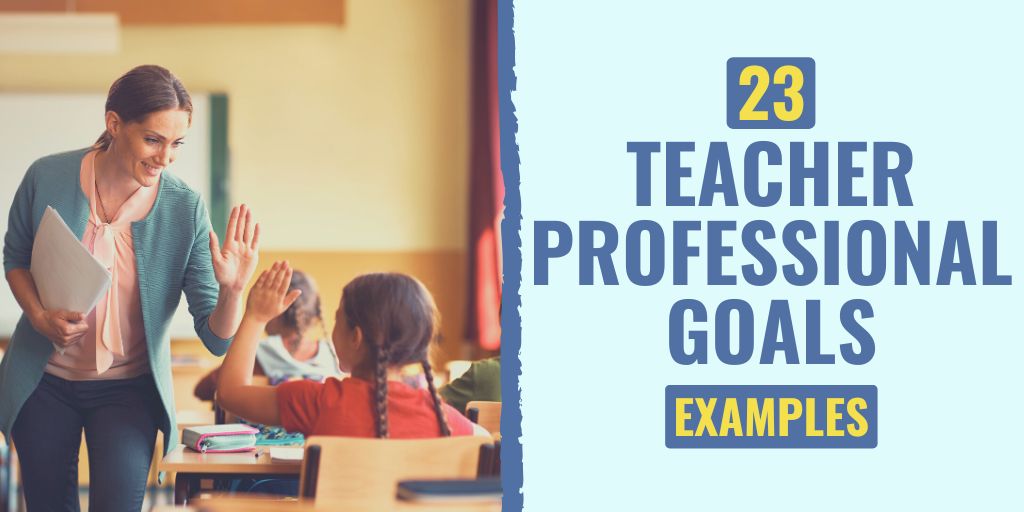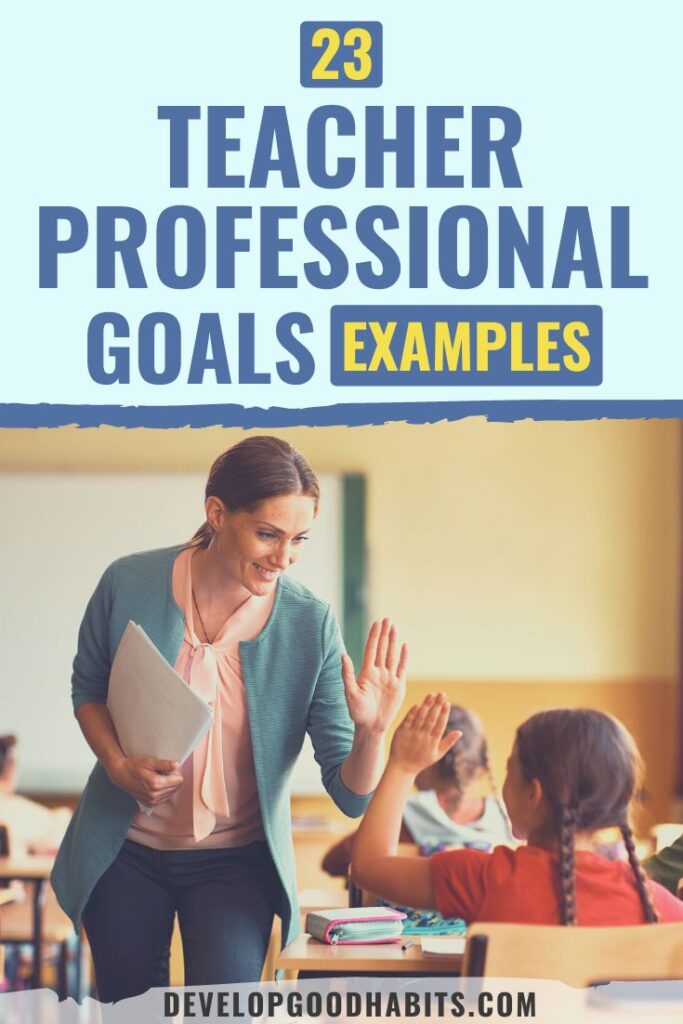There might be affiliate links on this page, which means we get a small commission of anything you buy. As an Amazon Associate we earn from qualifying purchases. Please do your own research before making any online purchase.
As a teacher in 2024, it's important to have clear goals in mind that will help you achieve success in the classroom and positively impact your students.
From improving student achievement, to fostering a growth mindset, the 23 goals listed below will serve as a comprehensive guide for teaching professionals looking to excel in their careers.
Whether you are a seasoned veteran, or just starting out… these goals will help you stay focused, motivated, and effective in your role as an educator. But keep in mind, it is not the goals themselves that will level you up as a teacher.
Instead, it is a combination of the pathway they generate, as well as the effect they have on your students when successfully executed, that will make you a much stronger educator.
By keeping these goals in mind and continuously working every day to achieve them, you will be a completely different person by the end of the year. So, what are we waiting for? Let's dive in!
What is Teacher Professional Goals?
Teacher professional goals are objectives that teachers set for themselves to ensure they can manage a classroom full of well-rounded students, while improving upon results that could lead to career-defining moments.
These goals are typically aligned and may focus on many different areas – including student achievement, classroom management, instructional strategies, and professional growth.
These specific goals are important as they cross a variety of challenging areas in the classroom, from inclusivity to fostering creativity.
By setting daily, weekly, and monthly checkups for yourself, you will eventually realize that you have achieved many of the goals we lay out below by the end of the school year.
15 Teacher Professional Goals for Success
1. Improve student achievement through assessments.
Student assessments are a critical tool for teachers as they can uncover in which areas their students need additional support. This information can then be used to inform what areas of study need to be focused on so students can move the needle on their education.
Teachers should use assessments on a regular basis to make minor or major adjustments to the curriculum in order to continue helping students achieve their goals.
More specifically, having assessments on a weekly or monthly basis can help the teacher gauge whether their students are meeting the goals needed for end-of-year testing.
2. Foster a positive and inclusive classroom culture.
Fostering a positive and inclusive classroom culture is crucial to creating an environment where all students feel valued and supported.
This goal requires teachers to actively work towards developing a welcoming atmosphere that celebrates the diversity of their students and promotes inclusivity.
Fostering positive relationships among students, promoting open communication, and addressing any issues that may arise in a respectful and constructive manner are some of the foundations that building an inclusive classroom is built from.

In an inclusive classroom, students should feel comfortable expressing their thoughts and ideas, and teachers should actively engage with all students, encouraging their participation and involvement in class activities.
Teachers can also promote inclusivity by integrating diversity into their curriculum, highlighting different perspectives and cultural experiences, and creating opportunities for students to work collaboratively through a multitude of projects.
By creating a positive and inclusive classroom culture, teachers can help their students feel supported, valued, and empowered to reach their full potential.
3. Utilize technology effectively in teaching.
The modern world is an increasingly tech-filled landscape. Using it effectively, however, is still something that needs to be prioritized, especially as an educator.
While using it can be tremendously advantageous, teachers must set goals when it comes to using technology to create an engaging and dynamic learning experience that supports student growth and development.
Teachers need to be familiar with a suite of software applications that can help them as well as their students better engage with classroom topics. Since many students have different learning styles, these tools can be used to help bridge the gap in disparity among students.
Teachers should also be mindful of the potential drawbacks of technology and ensure that it is used in a manner that enhances rather than detracts from student learning.
This may involve balancing the use of technology with traditional teaching methods and making sure students have access to the necessary resources and support to effectively utilize technology.
4. Implement evidence-based teaching practices.
Evidence-based teaching refers to the use of teaching strategies that have been supported by research and shown to be effective in classrooms across the country.
This requires teachers to stay up to date on all the latest educational research and best practices while being willing to continuously reflect on and refine their teaching methods.
This means that teachers need to be proactive when it comes to seeking out professional development opportunities and engaging in ongoing learning. This may involve attending workshops, conferences, and webinars, as well as participating in collaborative learning communities.
By considering evidence-based teaching practices, teachers can ensure that they are providing their students with the best possible classroom experience and environment.
5. Develop strong relationships with students and families.
Developing strong relationships with the families of your students is a crucial aspect of effective teaching. Teachers that build positive relationships with family members, especially parents, can create a supportive environment that fosters student engagement.
Being approachable, understanding, and empathetic to family needs can go a long distance in setting students up for future success.
Try initiating frequent communications with family members. Keeping your door open and actively listening to their concerns and ideas as well as providing support and resources when needed can prove instrumental for the student.
Teachers can also involve families in the learning experience by hosting events and activities that promote family engagement. Sharing information about their student's progress and achievements is another tried and true method of keeping the family engaged.
6. Foster critical thinking skills and collaborative environments.
Encouraging students to think critically and analyze information for themselves will help them develop the problem-solving skills they need to succeed down the line.
This means teachers should create learning experiences that challenge students to think deeply about some of the concepts they learn in the classroom so they can apply them to the real world.

Using hands-on activities, field trips, discussions, and simulations where there is more room for play will give students the foundation to apply their learned subjects more applicable to the real world through critical thinking.
This extends to group activities like projects that students can collaborate on with their peers. After all, so much of what we do in the real world is driven by collaboration.
7. Continuously grow and develop professionally.
Continuous professional growth and development are essential for teachers looking to stay effective with the changing social and technological shifts that happen in our world.
By attending workshops, conferences, and webinars, as well as participating in collaborative learning communities, teachers can gain skills and use the resources to remain at the top of their profession.
Additionally, evaluating your teaching methods on a regular basis and seeking out feedback from colleagues is a great way to develop professionally. A love of learning and an openness to try something new should be tools in every teacher's toolbox.
8. Encourage student engagement.
Encouraging engagement is one of the best ways you can set your students up for success. With a plethora of distractions ready to take effect in today's world, ensuring positive student engagement with subjects is paramount.
By creating an interactive and hands-on learning environment that gets the students thinking outside of the box about old concepts in new ways, teachers can help foster this positive engagement.
Try incorporating student-led projects into lesson plans and provide opportunities for students to work with real-world materials and technology. Incentivizing students with extra credit can be another effective way to encourage their engagement in a subject.
9. Use the data.
Thanks to the influx of tech tools, “the data” is used everywhere, whether you are in the hospital or in a business meeting. So why shouldn't it be used in the classroom?
Data can provide valuable insights into student strengths and weaknesses, and help teachers make informed decisions about instruction. What subjects are students struggling with and which students are struggling with, what subjects are critical questions that can be solved by looking at the data?
Regularly assessing student performance, analyzing the results, and using the information to inform lesson plans is a workflow that would never have been dreamed up twenty years ago.
Teachers need to have a clear understanding of the data they collect as well as how to interpret it. This may involve using data to differentiate instruction, identify areas where students need additional support, or just adjust teaching methods to better meet the needs of their students.
10. Integrate in-demand skills for the 21st century.
In some ways, the school system is still stuck in the 1950s. But there are opportunities to integrate skills like digital literacy, collaboration, and problem-solving, which are essential for students to thrive in a rapidly changing world.
To integrate these skills into daily lesson plans, teachers need to think outside of the box as well as consider the data on student performance.

Setting some time apart from the regular lesson to teach these skills through short exercises and bringing in guests from the real world to talk to students can be a great way to achieve this.
11. Develop strong classroom management skills.
Strong classroom management can foster a safe, positive, and productive learning environment. Effective classroom management involves creating clear expectations and routines, managing student behavior, and creating a classroom culture that recognizes how students are feeling and meets them there.
Classroom management relies on the teacher understanding their roles and responsibilities as well as executing a strong set of strategies for management.
This may involve using proactive strategies, such as setting clear expectations and routines, as well as reactive strategies, such as redirecting misbehavior or addressing disruptive behavior. Developing these skills can help the teacher support learning and success for all students.
12. Collaborate with colleagues.
Collaborating with colleagues allows teachers to share ideas, resources, and best practices and can lead to improved teaching and student outcomes.
To collaborate effectively, teachers must have strong communication skills, and be open to new ideas and approaches. They should also be proactive in seeking out opportunities to collaborate with their colleagues, and be willing to share their own expertise and experience.
Collaboration can take many different forms, from regular meetings online or in-person to working together on school-wide initiatives or projects.
13. Provide individualized instruction.
Differentiating instruction often involves tailoring teaching methods and materials to meet the individual needs of each student. This is a complicated task because each student varies greatly in their strengths and weaknesses.
To provide individualized instruction, teachers must have a strong understanding of each student's abilities, interests, and learning styles. They should also develop a strong set of teaching strategies and technologies to help each student succeed in the weekly or monthly curriculum.
Teachers can also work to build strong relationships with students and families to better understand what home life is like and, therefore, get better clues on what might aid them in the classroom.
By providing individualized instruction, teachers can ensure that all students can learn and reach their full potential. This can lead to improved student engagement and motivation, and higher student achievement.
14. Foster creativity and innovation.
Encouraging students to think outside the box and embrace new and creative ideas can lead to better subject matter retention. Hands-on learning that gets students off their feet and moving around can be a great way to spark their innate creative talents.
Teachers can do this by creating a supportive and inclusive learning environment that values and encourages creativity, no matter where the child goes with it.
They can also incorporate activities and projects into their lessons that spark creativity and provide opportunities for students to explore their own interests and ideas. This can lead to improved student engagement and motivation, and higher student achievement.
15. Foster a growth mindset in students.
A growth mindset is important for everyone, not just students. Fostering it at a young age can set the child up for success well beyond the classroom.
Developing a growth mindset involves embracing challenges and persevering through difficulties to uncover the hidden potential in one's own talent. By creating a supportive and inclusive learning environment, teachers can get students to take more risks and embrace challenges.
A safe environment that ensures students that everything will be ok if they fail is one of the most crucial things a teacher can create in the learning space. Fostering a growth mindset helps students build up the resilience they will need as they face challenges in life.
Having a growth mindset means embracing challenges as opportunities for learning and growth. If you want to learn more, then take a few minutes to watch this video:
16. Increase attendance.
Are you in a situation in which you're having issues with maintaining student attendance? Before you get mad at the students, try to understand their situation. Some students may have a troubled home life.
Some students may be floating between two homes because their parents are going through a divorce. Some students may just not be motivated or are dealing with an undiagnosed learning disability.
Whatever the reason, you can use different steps to increase attendance by promoting a positive attitude towards school. Establish your own attendance tracking system to see if you notice patterns and trends that are alarming.
Begin by checking out last year's attendance rates and make it a goal to increase it by a certain percentage, such as 10% or 20% for the current year.
When you encourage positive reinforcement in the classroom and reward any student for good attendance, students will feel that their voices are being heard. Then they’ll be more likely to show up on time.
17. Increase reading levels.
If you're trying to increase reading levels, you don't have to rely just on the school curriculum. Encourage students to read as often as possible with tools they prefer.
Give students 5 or 15 minutes of in class time to read their own book or article. Or you can consider reading out loud to students from a book that you're reading at home or a different academic book. Choose a current news article, comic book, academic book, or poetry book to read out loud together as a class.
You can get students to further participate in reading by allowing each student to pick a book, article, or poem that the entire class has to read by the following week, and everyone will get together and discuss it.
18. Increase creative writing opportunities.
Writing is just as important as reading at all levels. You can incorporate writing prompts along with your reading segments. In other words, have students write something related to the book, poem, or article they’re assigned every week.
Allow students to read their writing out loud and have each class discussion around it. You can also encourage students to keep a journal in which you'll give them writing prompts. Collect the journals every week and give supportive feedback to what students write, regardless of how little or how much they write in it.
You can also allow students to provide writing prompts for the class and turn it into a fun or serious activity, depending on the topic.
19. Hire a career coach.
Teaching is your career that you've put a lot of time and effort into. There's nothing wrong with hiring a career coach to move you further along, regardless of how many years you've been in the game. A career coach will help you clarify the career goals you have as a teacher. Maybe you want to remain in the classroom.
Maybe you want to switch over to a different age group. Maybe you want to open an online tutoring school or move to international teaching. A career coach can help walk you through the process to help you achieve such a goal within a realistic amount of time.
If your career goals involve having to achieve a certification, do certain networking, learn a new subject matter, a career coach can give you the tools you need to get started.
20. Encourage peer teaching help.
While you may already be doing collaborative group work and teamwork, you can also take it a step further by encouraging students to teach the class for a certain segment.
You can even make it more structured by having students prepare a short lesson plan around any topic of their choosing, but they have to find a way to work it into the overall class subject.
Give students positive feedback about their particular lesson plan and teaching method. This can encourage more shy students to use their voices and show them how they can teach anything.
21. Incorporate current events into teaching.
Regardless of what subject you teach, you could find a way to incorporate current events into your curriculum. For example, if you're a math teacher, you may want to discuss numbers by talking about how Warren Buffett does stock trading or the percentages in which Bitcoin has risen or fallen for today.
Do you teach history? Try to find something that happened on this day 10, 50 or 200 years ago. You can use different sources ranging from videos, podcasts, and documentaries. You can also create in-class or homework assignments based around current events.
22. Watch other professionals teach.
You can always learn so much from watching other professionals teach. Don't make the mistake of thinking because you're an experienced teacher that you couldn't learn from a new one, or that you can’t learn from a teacher who's been teaching as long as you have.
Different teachers have different methods that can vary based on their personality, culture, and life experience. You can gain a lot from opening up your horizons and seeing how your peers are doing things.
If you don't feel comfortable watching peers at your school, ask to visit another school. Whether it's one at your teaching level or a different one, you can get a better grasp on how different teaching methods work.
23. Invite an observer.
On the flip side, have someone watch you teach. While it can be nerve-wracking when you're being assessed by professional administration, it may not be so nerve-wracking when you're inviting someone in to observe you.
Invite another teacher that you trust and will give an honest opinion. You can also record yourself teaching and send a video to another peer at your school or who works elsewhere.
Final Thoughts on Teacher Professional Goals
Teachers have a major responsibility for the role they play in developing the future pillars of society. As every student is different, and an individual, it is important to meet each child where they are to help them succeed in class. Every student must be treated on a case-by-case basis.
Beyond succeeding in the classroom, fostering a love for challenges and creativity can be an instrumental concept to shape a student's life outside academia. Learning and educating is a lifelong process.
Hopefully, these teacher professional goals examples give you some ideas for what you can do in your own classroom and beyond.
And if you want more SMART goal ideas and examples, be sure to check out these blog posts:
- 10 SMART Goals Examples for an IEP (Individualized Education Program)
- 11 SMART Goals Examples for Special Education Teachers
- 9 SMART Goals Examples for Teachers
Finally, if you want to take your goal-setting efforts to the next level, check out this FREE printable worksheet and a step-by-step process that will help you set effective SMART goals.


